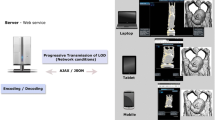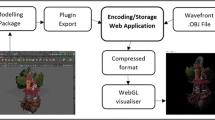Abstract
Modern Web 3D technologies allow us to display complex interactive 3D content, including models, textures, sounds and animations, using any HTML-enabled web browser. Thus, due to the device-independent nature of HTML5, the same content might have to be displayed on a wide range of different devices and environments. This means that the display of Web 3D content is faced with the same Quality of Experience (QoE) issues as other multimedia types, concerning bandwidth, computational capabilities of the end device, and content quality. In this paper, we present a framework for adaptive streaming of interactive Web 3D scenes to web clients using the MPEG-DASH standard. We offer an analysis of how the standard’s Media Presentation Description schema can be used to describe adaptive Web 3D scenes for streaming, and explore the types of metrics that can be used to maximize the user’s QoE. Then, we present a prototype client we have developed, and demonstrate how the 3D streaming process can take place over such a client. Finally, we discuss how the client framework can be used to design adaptive streaming policies that correspond to real-world scenarios.










Similar content being viewed by others
References
Alliez P, Desbrun M (2001) Progressive compression for lossless transmission of triangle meshes. Computer Graphics (SIGGRAPH-01), Proceedings of the Annual Conference on, 195–202, ACM
Behr J, Jung Y, Franke T, Sturm T, (2012) Using images and explicit binary container for efficient and incremental delivery of declarative 3D scenes on the web. Web3D Technology (Web3D), 17th International Symposium on, 17–25, ACM
Behr J, Jung Y, Keil J, Drevensek T, Zollner M, Eschler P, Fellner D (2010) A scalable architecture for the HTML/X3D integration model X3DOM. Web 3D Technology (Web3D), 15th International Conference on, 185–194, ACM
Bourdena A, Kormentzas G, Pallis E, Mastorakis G (2013) Radio resource management algorithms for efficient QoS provisioning over cognitive radio networks. Communications (ICC), 2013 I.E. International Conference on, 2415–2420
Brooks RJ, Tobias AM (1996) Choosing the best model: level of detail, complexity, and model performance. Math Comput Model 24(4):1–14
Carmona-Murillo J, Gonzalez-Sanchez JL, Cortes-Polo D, Rodriguez-Perez FJ (2014) QoS in Next generation mobile networks: an analytical study. In Mavromoustakis CX, Pallis E, Mastorakis G (eds) Resource management in mobile computing environments. Springer International Publishing, pp. 25–41
Coding of audio-visual objects - Part 11: scene description and application engine, ISO/IEC 14496–11:2014
Dynamic adaptive streaming over HTTP (DASH) — Part 1: media presentation description and segment formats, ISO/IEC 23009–1:2014
Extensible 3D (X3D), ISO/IEC 19775:2004/Am1:2006
Extensible 3D (X3D) encodings, ISO/IEC 19776:2005
Gandoin PM, Devillers O (2002) Progressive lossless compression of arbitrary simplicial complexes. Computer Graphics and Interactive Techniques (SIGGRAPH-02), Proceedings of the ACM Conference on, 372–379, ACM
Hoppe H (1996) Progressive meshes. Computer graphics (SIGGRAPH-96), Proceedings of the ACM Conference on, 99–108, ACM
Kapetanakis K, Panagiotakis S, Malamos AG, Zampoglou M (2014) Adaptive Video Streaming on top of Web3D: A bridging technology between X3DOM and MPEG-DASH. Telecommunications and Multimedia (TEMU), Proceedings of the 6th IEEE International Conference on, 226–231
Kapetanakis K, Zampoglou M, Malamos AG, Panagiotakis S, Maravelakis E (2014) An MPEG-DASH framework for QoE-aware Web3D streaming. International Journal of Wireless Networks and Broadband Technologies (IJWNBT) 3(4):1–20. doi:10.4018/ijwnbt.2014100101, IGI Global
Kapetanakis K, Zampoglou M, Milionis F, Malamos AG, Panagiotakis S, Maravelakis E (2014) State-of-the-art web technologies for progressive presentation of synthetic cultural heritage scenes, Information, Intelligence, Systems and Applications (IISA 2014), Proceedings of the 5th IEEE International Conference on, 211–216
Lavoue G, Chevalier L, Dupont F (2013) Streaming compressed 3D data on the web using javascript and webGL, Web3D Technology (Web3D) 18th International Conference on, 19–27, ACM
Limper M, Jung Y, Behr J, Alexa M (2013) The POP buffer: rapid progressive clustering by geometry quantization. Comput Graph Forum 32(7):197–206
Limper M, Wagner S, Stein C, Jung Y, Stork A (2013) Fast delivery of 3D web content: a case study. Web 3D Technology (Web3D), In Proceedings of the 18th International Conference on, 11–17, ACM
Luebke DP (2003) Level of detail for 3D graphics. Morgan Kaufmann
Lv Z, Li X, Zhang B, Wang W, Zhu Y, Hu J, Feng S (2016) Managing big city information based on WebVRGIS. IEEE Access 4:407–415
Lv Z, Réhman SU, Chen G (2013). Webvrgis: A p2p network engine for vr data and gis analysis. In International Conference on Neural Information Processing (pp. 503–510). Springer Berlin Heidelberg
Mamou K, Dehais C, Chaieb F, Ghorbel F (2010) Shape approximation for efficient progressive mesh compression. Image Processing (ICIP), Proceedings of the IEEE International Conference on, pp. 3425–3428
Narayanan RGL (2014) Mobile video streaming resource management. In Mavromoustakis CX, Pallis E, Mastorakis G (eds) Resource management in mobile computing environments, Springer International Publishing, pp. 461–480
Peng J, Kuo CCJ (2005) Geometry-guided progressive lossless 3D mesh coding with octree (OT) decomposition. ACM Trans Graph 24(3):609–616
Stamoulias A, Malamos AG, Zampoglou M, Brutzman D (2014) Enhancing X3DOM declarative 3D with rigid body physics support. 3D Web Technologies (Web3D), Proceedings of the Nineteenth International ACM Conference on, 99–107, ACM
The Virtual Reality Modeling Language (VRML) – Part 2: external authoring interface (EAI), ISO/IEC 14772–2:2004
The Virtual Reality Modeling Language – part 1: functional specification and UTF-8 encoding, ISO/IEC 14772–1:1997
Valette S, Chaine R, Prost R (2009) Progressive lossless mesh compression via incremental parametric refinement. Comput Graph Forum 28(5):1301–1310
Acknowledgements
The research of this paper is granted by the European Union and the Hellenic General Secretary of Research and Technology under the “COOPERATION 2009/09SYN-72-956” Framework.
Author information
Authors and Affiliations
Corresponding author
Rights and permissions
About this article
Cite this article
Zampoglou, M., Kapetanakis, K., Stamoulias, A. et al. Adaptive streaming of complex Web 3D scenes based on the MPEG-DASH standard. Multimed Tools Appl 77, 125–148 (2018). https://doi.org/10.1007/s11042-016-4255-8
Received:
Revised:
Accepted:
Published:
Issue Date:
DOI: https://doi.org/10.1007/s11042-016-4255-8




